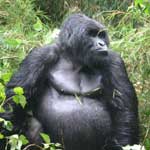Report of the Joint CBD CITES meeting on Bushmeat 15th August 2011  Report of the Joint Meeting of the CBD Liaison Group on Bushmeat and the CITES Central Africa Bushmeat Working Group Report of the Joint Meeting of the CBD Liaison Group on Bushmeat and the CITES Central Africa Bushmeat Working Group
The ‘empty forest syndrome’ - a loss of forest fauna has reached critical levels in many countries across the tropics and sub-tropics.
Population growth, poverty in rural areas and the absence of livelihood alternatives, increased urban consumption, forestry activities, and extractive industries in remote forests are all contributing to unsustainable levels of commercial and subsistence hunting.
The increasing scale and commercialization of bushmeat use is also posing a severe threat to the food security, customary practices, livelihoods, and cultural and spiritual identity of indigenous peoples and local communities.
The Joint Meeting of the CBD Liaison Group on Bushmeat and the CITES Central Africa Bushmeat Working Group met in June 2011, in Nairobi, Kenya
The meeting endorsed the recommendations of the first meeting of the Liaison Group on Bushmeat in Buenos Aires, Argentina (October 2009) and added key revisions and additions. The recoomendatiosn now fall under the following areas:
National level
1) Increasing capacity to fully evaluate the bushmeat issue and establish appropriate policies and management regimes
2) Engaging the private sector and extractive industries
3) Land and resource rights and traditional knowledge
4) Landscape-level management
5) Science, traditional and indigenous knowledge and monitoring
6) Substitution and other mitigative measures
7) Capacity-building, training, education and awareness-raising
8) Health and epidemiology
9) Climate change
10) Special management areas
11) Law enforcement
12) National strategies and action plans to address bushmeat
International level
1) National, regional and international strategies to address bushmeat
2) Participatory processes
3) Impacts of international trade in natural resources
4) International trade in bushmeat
5) International policy environment
6) Science
7) Incentives
8) Forest certification
The joint meeting recommended to the fifteenth meeting of the Subsidiary Body on Scientific, Technical and Technological Advice (SBSTTA) of the Convention on Biological Diversity to forward these recommendations for adoption to the eleventh meeting of the Conference of the Parties. The outcomes of the meeting are also being discussed this week during the Sixty-first meeting of the CITES Standing Committee, and reporting to the Conference of the Parties to CITES at its 16th meeting.
The group specifically recommended a number of approaches for alternatives to unsustainable harvesting of bushmeat, including:
1) Sustainable wildlife management, community wildlife management, game ranching, and hunting tourism;
2) Domestication and raising of wild animals in small farms (mini-livestock);
3) Sustainable harvesting of non-timber forest products; and
4) Certification and eco-labelling of wildlife products.
The full report of the Joint Meeting of the CBD Liaison Group on Bushmeat and the CITES Central Africa Bushmeat Working Group is available on the CBD website.
|











